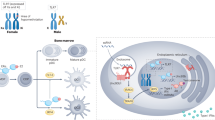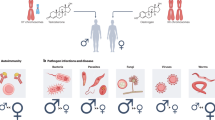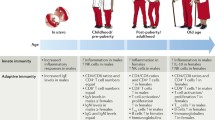Summary
The status of the present knowledge on the mammalian sex-specific antigens (“H-Y antigens”) is reviewed and critically discussed. Special weight is given to problems related to three major topics, i.e., the immunology, genetics, and biological function(s) of these antigens. Current hypotheses as to the function(s) and the genetic control of the sex-specific antigens are individually scrutinized. Finally, some prospects for further H-Y research which seems especially urgent are briefly suggested.
Similar content being viewed by others
References
Bacon LD, Craig JV (1966) Evidence for a histocompatibility locus on the W chromosome in chickens. Poult Sci 45:1066–1067
Bennett D, Mathieson BJ, Scheid M, Yanagisawa K, Boyse EA, Wachtel SS, Cattanach BM (1977) Serological evidence for H-Y antigen in Sxr, XX sex-reversed phenotypic males, Nature 265: 255–257
Billingham RE, Hings IM (1981) The H-Y antigen and its role in natural transplantation. Hum Genet 58:9–17
Billingham RE, Silvers WK (1960) Studies on tolerance of the Y chromosome antigen in mice. J Immunol 85:14–16
Billingham RE, Silvers WK, Wilson DB (1965) A second study on the H-Y transplantation antigen in mice. Proc R Soc Lond [Biol] 163: 61–89
Bradley M, Heslop B (1984) An improved urease ELISA protocol for the screening of monoclonal H-Y antibodies. Proc Univ Otago Med Sch 62:14–16
Bradley MP, Heslop BF (1985) Elicitation of a rapid and transient antibody response to H-Y antigen by intrasplenic immunization. Transplantation 39:634–638
Bradley M, Ebensperger C, Wiberg U (1987) Determination of the serological sex-specific (Sxs) antigen (“H-Y antigen”) in birds and mammals using high-titer antisera and a sensitive urease ELISA. Hum Genet 76 (in press)
Burgoyne PS (1982) Genetic homology and crossing over in the X and Y chromosomes of mammals. Hum Genet 61:85–90
Burgoyne PS, Levy ER, McLaren A (1986) Spermatogenic failure in male mice lacking H-Y antigen. Nature 320:170–172
Casanova-Bettane M, Fellous M (1981) Antigène H-Y et dysgénésis sexuelles chez l'homme. CR Soc Biol (Paris) 175:8–18
Cattanach BM, Pollard CE, Hawkes SG (1971) Sex-reversed mice; XX and XO males. Cytogenetics 10:318–337
Cattanach BM, Evans EP, Burtenshaw MD, Barlow J (1982) Male, female and intersex development in mice of identical chromosome constitution. Nature 300:445–446
Celada F, Welshons WJ (1963) An immunogenetic analysis of the male antigen in mice utilizing animals with an exceptional chromosome constitution. Genetics 48:139–151
Chapelle A de la, Koo GC, Wachtel SS (1978) Recessive sex-determining genes in human XX male syndrome. Cell 15:837–842
Eco U (1986) Der Name der Rose (German translation of: Il nome della rosa). Deutscher Taschenbuch Verlag, München, pp 17 and 639 (Latin citation of Paulus; 1. Kor. 13, 12)
Eicher E, Washburn LL, Whitney JB III, Morrow KE (1982) Mus poschiavinus Y chromosome in the C57BL/6J murine genome causes sex reversal. Science 217:535–537
Eicher EM, Phillips SJ, Washburn LL (1983) The use of molecular probes and chromosomal rearrangements to partition the mouse Y chromosome into functional regions. In: Messer A, Porter IH (eds) Recombinant DNA and medical genetics. Academic Press, New York, pp 57–71
Eichwald EJ, Silmser CR (1955) Untitled communication. Transplant Bull 2:148–149
Engel W, Klemme B, Ebrecht A (1981) Serological evidence for H-Y antigen in XO female mice. Hum Genet 57:68–70
Evans EP, Burtenshaw MD, Cattanach BM (1982) Meiotic crossingover between the X and Y chromosomes of male mice carrying the sex-reversing factor. Nature 300:443–445
Fellous M, Günther E, Kemler R, Wiels J, Berger R, Guenet JL, Jakob H, Jacob F (1978) Association of the H-Y male antigen with β2 on human lymphoid and differentiated mouse teratocarcinoma cell lines. J Exp Med 147:58–70
Gilmour DG (1967) Histocompatibility antigen in the heterogametic sex in the chicken. Transplantation 5:699–706
Goldberg EH, Boyse EA, Bennett D, Scheid M, Carswell EA (1971) Serological demonstration of H-Y (male) antigen on mouse sperm. Nature 232:478–480
Goldberg EH, Boyse EA, Scheid M, Bennett D (1972) Production of H-Y antibody by female mice that fail to reject male skin. Nature [New Biol] 238:55–57
Goldberg EH, Shen F, Tokuda S (1973) Detection of H-Y (male) antigen on mouse lymph node cells by the cell to cell cytotoxicity test. Transplantation 15:334–336
Goodfellow PN, Andrews PW (1982) Sexual differentiation and H-Y antigen. Nature 295:11–13
Gordon RD, Simpson E, Samelson LE (1975) In vitro cell-mediated immune responses to the male specific (H-Y) antigen in mice. J Exp Med 142:1108–1120
Goulmy E, Termijtelen A, Bradley BA, van Rood JJ (1977) Y-antigen killing by T cells of women is restricted by HLA. Nature 266: 544–545
Goulmy E, van Leeuwen A, Blokland E, Sachs ES, Geraedts JPM (1983) The recognition of abnormal sex chromosome constitution by HLA-restricted anti H-Y cytotoxic T cells and antibody. Immunogenetics 17:523–531
Harbers K, Soriano P, Müller U, Jaenisch R (1986) High frequency of unequal recombination in pseudoautosomal region shown by proviral insertion in transgenic mouse. Nature 324:682–685
Haseltine FP, DePonte KK, Breg WR, Genel M (1982) Presence of H-Y antigen in patients with Ullrich-Turner syndrome and X chromosome rearrangements. Am J Med Genet 11:97–107
Herbst EW, Fredga K, Frank F, Winking H, Gropp A (1978) Cytological identification of two X-chromosome types in the wood lemming (Myopus schisticolor). Chromosoma 69:185–191
Hildemann WH (1970) Immunogenetics. Holden-Day, San Francisco, p 182
Hurme M, Chandler PR, Hetherington CM, Simpson E (1978) Cytotoxic T-cell responses to H-Y: correlation with the rejection of syngeneic male skin grafts. J Exp Med 147:768–775
Johnson LL, Sargent EL, Washburn LL, Eicher EM (1982) XY female mice express H-Y antigen. Dev Genet 3:247–253
Keitges EA, Schorderet DF, Gartler SM (1986) Linkage of the murine steroid sulfatase locus and the sex reversed mutation. Am J Hum Genet [Suppl] 39:A118
Kiel-Metzger K, Erickson RP (1984) Regional localization of sex-specific Bkm-related sequences on proximal chromosome 17 of mice. Nature 310:579–581
Kiel-Metzger K, Warren G, Wilson GN, Erickson RP (1985) Evidence that the human Y chromosome does not contain clustered DNA sequences (Bkm) associated with heterogametic sex determination in other vertebrates. N Engl J Med 313:242–245
Klein J (1982) Immunology: the science of self-nonself discrimination. Wiley, New York, pp 349, 478
Koo GC, Reidy JA, Nagamine CM (1983) H-Y antigen in XO mice. Immunogenetics 18:37–44
Králová J, Démant P (1976) Expression of the H-Y antigen on thymus cells and skin: differential genetic control linked to K end of H-2. Immunogenetics 3:583–594
Lau Y-F, Chan K, Kan YW, Goldberg E (1986) Isolation of a male-specific and conserved gene using an anti-H-Y antibody. Am J Hum Genet [Suppl] 39:A142
McCarrey JR, Abplanalp H, Abbott UK (1981) Studies on the H-W (H-Y) antigen in chickens: evidence for H-W monomorphism and line specific restriction of graft rejection. J Hered 72:169–171
McLaren A, Simpson E, Tomonari K, Chandler P, Hogg H (1984) Male sexual differentiation in mice lacking H-Y antigen. Nature 312:552–555
Mayerovà A, Müller U, Wiberg U, Wolf U, Fraccaro M (1984) Variability in the amount of serologically detectable H-Y antigen. Hum Genet 66:110–112
Welvold RW, Kohn HI, Yerganian G, Fawcett DW (1977) Evidence suggesting the existence of two H-Y antigens in the mouse. Immunogenetics 5:33–41
Mittwoch U (1977) H-Y antigen and the growth of the dominant gonad. J Med Genet 14:335–338
Mittwoch U (1986) Males, females and hermaphrodites. Ann Hum Genet 50:103–121
Moreira-Filho CA, Wachtel SS (1985) Study of H-Y antigen in abnormal sex determination with monoclonal antibody and an ELISA. Am J Med Genet 20:525–534
Müller U, Aschmoneit I, Zenzes MT, Wolf U (1978) Binding studies of H-Y antigen: indication for a gonad specific receptor. Hum Genet 43:151–157
Müller U, Wolf U, Siebers JW, Günther E (1979) Evidence for a gonad-specific receptor for H-Y antigen: binding of exogenous H-Y antigen to gonadal cell is independent of β2-microglobulin. Cell 17:331–335
Müller U, Donlon TA, Kunkel SM, Lalande M, Latt SA (1987) Y-190, a DNA probe for the sensitive detection of Y-derived marker chromosomes and mosaicism. Hum Genet 75:109–113
Nagai Y, Ciccarese S, Ohno S (1979) The identification of human H-Y antigen and testicular transformation induced by its interaction with the receptor site of bovine fetal ovarian cells. Differentiation 13:155–164
Ohno S (1976) Major regulatory genes for mammalian sexual development. Cell 7:315–321
Ohno S (1979) Major sex determining genes. Springer, New York Berlin Heidelberg
Ohno S, Nagai Y, Ciccarese S (1978) Testicular cells lysostripped of H-Y antigen organize ovarian follicle-like aggregates. Cytogenet Cell Genet 20:351–364
Ohno S, Nagai Y, Ciccarese S, Iwata H (1979) Testis-organizing H-Y antigen and the primary sex-determining mechanism of mammals. Recent Prog Horm Res 35:449–476
Pfeffer PF, Thorsby E (1982) HLA-restricted cytotoxicity against male-specific (H-Y) antigen after acute rejection of an HLA-identical sibling kidney. Transplantation 33:52–56
Polani PE, Adinolfi M (1983) The H-Y antigen and its functions: a review and a hypothesis. J Immunogenet 10:85–102
Scheid M, Boyse EA, Carswell EA, Old LJ (1972) Serologically demonstrable alloantigens of mouse epidermal cells. J Exp Med 135: 938–955
Shapiro M, Erickson RP (1981) Evidence that the serological determinant of H-Y antigen is carbohydrate. Nature 290:503–505
Shapiro M, Goldberg EH (1984) Analysis of a serological determinant of H-Y antigen: evidence for carbohydrate specificity using an H-Y specific monoclonal antibody. J Immunogenet 11:209–218
Shearer GM, Hurtenbach U (1982) Is sperm immunosuppressive in male homosexuals and vasectomized men? Immunol Today 3: 153–154
Silvers WK, Yang S-L (1973) Male specific antigen: its homology in mice and rats. Science 181:570–572
Silvers WK, Gasser DL, Eicher EM (1982) H-Y antigen, serologically detectable male antigen and sex determination. Cell 28:439–440
Simpson E (1982) The role of H-Y as a minor transplantation antigen. Immunol Today 3:97–106
Simpson E, Edwards P, Wachtel S, McLaren A, Chandler P (1981) H-Y antigen in Sxr mice detected by H-2-restricted cytotoxic T cells. Immunogenetics 13:355–358
Simpson E, McLaren A, Chandler P (1982) Evidence for two male antigens in mice. Immunogenetics 15:609–614
Simpson E, Chandler P, Hunt R, Hogg H, Tomonari K, McLaren A (1986) H-Y status of X/XSrx' male mice: in vivo tests. Immunology 57:345–349
Simpson E, Chandler P, Goulmy E, Page DC, Disteche C, Ferguson-Smith MA (1987) Separation of the genetic loci for the H-Y antigen and testis determination on human Y chromosome. Nature 326:876–878
Singh L, Jones KW (1982) Sex reversal in the mouse (Mus musculus) is caused by a recurrent nonreciprocal crossover involving the X and an aberrant Y chromosome. Cell 28:205–216
Tiepolo L, Zuffardi O (1976) Localization of factors controlling spermatogenesis in the nonfluorescent protion of the human Y chromosome long arm. Hum Genet 34:119–124
Wachtel SS (1983) H-Y antigen and the biology of sex determination. Grune & Stratton, New York
Wachtel SS, Koo GC, Zuckerman EE, Hammerling U, Scheid M, Boyse EA (1974) Serological crossreactivity between H-Y (male) antigens of mouse and man. Proc Natl Acad Sci USA 71:1215–1218
Wachtel SS, Ohno S, Koo GC, Boyse EA (1975) Possible role for H-Y antigen in the primary determination of sex. Nature 257:235–236
Wachtel SS, Koo GC, Breg WR, Thaler HT, Dillard GM, Rosenthal IM, Dosik H, Gerald PS, Saenger P, New M, Lieber E, Miller OJ (1976) Serologic detection of a Y-linked gene in XX males and XX true hermaphrodites. N Engl J Med 295:750–754
Waibel F, Scherer G, Fraccaro M, Hustinx TWJ, Weissenbach J, Wieland J, Mayerová A, Back E, Wolf U (1987) Absence of Y-specific DNA sequences in human 46,XX true hermaphrodites and in 45,X mixed gonadal dysgenesis. Hum Genet 76 (in press)
Washburn LL, Eicher EM (1983) Sex reversal in XY mice caused by dominant mutation on chromosome 17. Nature 303:338–340
Wiberg UH (1985a) H-Y transplantation antigen in human XO females. Hum Genet 69:15–18
Wiberg UH (1985b) The role of sex chromosomes and sex chromosomal genes in vertebrate sex determination. Doctoral thesis, University of Lund (can be obtained on request from the author)
Wiberg U, Fredga K (1985) The H-Y transplantation antigen is present in XO and X*X female wood lemmings (Myopus schisticolor). Immunogenetics 22:495–501
Wiberg UH, Günther E (1985) Female wood lemmings with the mutant X*-chromosome carry the H-Y transplantation antigen. Immunogenetics 21:91–96
Wiberg UH, Lattermann U (1987) Syngeneic male graft rejection by B6 female mice primed with spleen and testes of Sxr and Sxr' mice. Exp Clin Immunogenet (in press)
Wiberg UH, Mayerová A (1985) Serologically H-Y antigen-negative XO mice. J Immunogenet 12:55–63
Wiberg U, Mayerová A, Müller U, Fredga K, Wolf U (1982) X-linked genes of the H-Y antigen system in the wood lemming (Myopus schisticolbr). Hum Genet 60:163–166
Wolf U (1978) Zum Mechanismus der Gonadendifferenzierung. Bull Schweiz Akad Med Wiss 34:357–368
Wolf U (1980) Studies on H-Y antigen in disorders of sexual development. In: Netter A, Gorius A (eds) Actualités gynécologiques, 11e sér. Masson, Paris, pp 95–107
Wolf U, Fraccaro M, Mayerová A, Hecht T, Maraschio P, Hameister H (1980a) A gene controlling H-Y antigen on the X chromosome. Tentative assignment by deletion mapping to Xp223. Hum Genet 54:149–154
Wolf U, Fraccaro M, Mayerová A, Hecht T, Zuffardi O, Hameister H (1980b) Turner syndrome patients are H-Y positive. Hum Genet 54:315–318
Zenzes MT, Wolf U, Engel W (1978) Organization in vitro of ovarian cells into testicular structures. Hum Genet 44:333–338
Author information
Authors and Affiliations
Rights and permissions
About this article
Cite this article
Wiberg, U.H. Facts and considerations about sex-specific antigens. Hum Genet 76, 207–214 (1987). https://doi.org/10.1007/BF00283605
Received:
Revised:
Issue Date:
DOI: https://doi.org/10.1007/BF00283605




